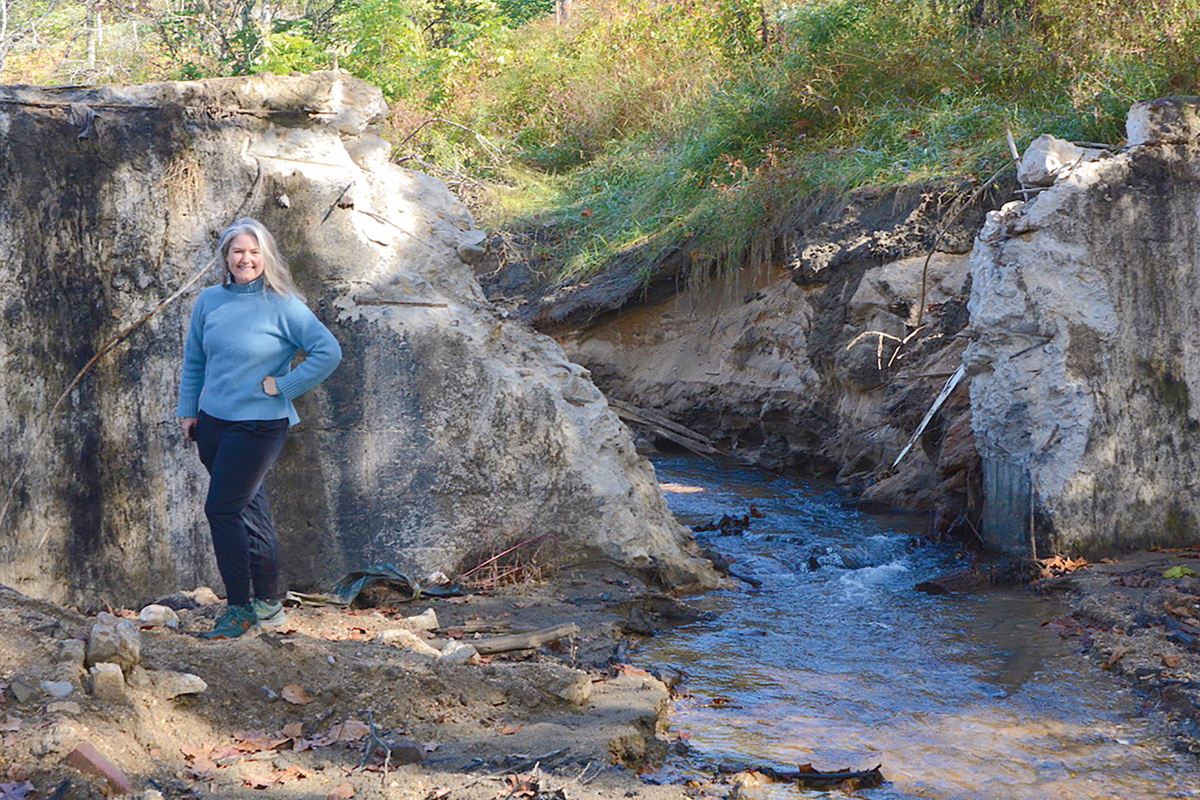Clearing the creek: Dam removal project frees Beaverdam watershed
 American Rivers Southeast Conservation Director Erin McCombs stands next to the recently cut notch in the Beaverdam Creek dam. Holly Kays photo
American Rivers Southeast Conservation Director Erin McCombs stands next to the recently cut notch in the Beaverdam Creek dam. Holly Kays photo
Beaverdam Creek is easy to miss. Tree-lined banks shield the small, shallow stream from view as it runs toward the Pigeon River in Canton, and until their leaves fall in winter, the trees also hide the dam blocking the creek’s flow just above the confluence.
Or, at least, they did. Now, for the first time in a century, Beaverdam Creek flows free.
A forgotten dam
The story started in 2015, when Brad Stanback, a N.C. Wildlife Resources Commissioner and conservation philanthropist who lives at the top of the Beaverdam Creek watershed, first noticed the dam near the corner of Champion Drive and Beaverdam Street.
“I just happened to look out the window in Canton as I was driving home and saw this dam that disconnected my own watershed,” he said. “I stopped and took a photo and sent it to American Rivers.”
American Rivers, a national nonprofit with an office in Asheville, has vast experience with supporting dam removal efforts . Not all dams are good candidates for removal — some are important for electric generation or water supply, for example — but in many cases dam removal can help the environment while reducing risks for human communities downstream.
Related Items
The Beaverdam Creek dam fell into the latter category.
There’s hardly any written information about the structure, said Erin McCombs, southeast conservation director for American Rivers. But from conversations with locals, she learned that the dam was built in the early 1900s. A general store operated on the adjacent property, along with a grist mill powered using water from the dam. People would bring their grain and have it milled into flour.
Today, the mill wheel is long gone, leaving only a small dam as a testament to times gone by.
“This thing has not been functioning for many, many decades, not been serving a purpose for a really long time,” McCombs said. “So at this point, not only is it blocking fish passage, but [it’s a] public safety hazard.”

Heavy machinery rips a notch in the dam Sept. 26. Brad Stanback photoHeavy machinery rips a notch in the dam Sept. 26. Brad Stanback photo
Doing a controlled removal, American Rivers decided, was a much better solution than waiting for the aging structure to fail on its own. The landowner agreed, granting the nonprofit access to his property to pursue the removal. Other partnerships were also key to the project, with Haywood Waterways Association, the Town of Canton and the U.S. Fish and Wildlife Service all collaborating to make it happen.
“It took a few years to get all the permits and permissions finalized, but eventually everything was set,” Stanback said.
A joint effort
Dam removal projects are never simple, even when there’s no controversy and the impoundments are small.
“Despite how small the project is, it is deceptively complicated,” McCombs said.
A sewer line runs along the erstwhile impoundment, and regulators had to be certain removal efforts would not damage that infrastructure or cause contamination of the stream. Public safety is also a key consideration when conducting dam removal projects — and fundraising is always a challenge.
“That was something that took a really long time,” McCombs said.

For about a century, the dam blocked Beaverdam Creek just a couple hundred feet from its confluence with the Pigeon River on the other side of Champion Drive. Holly Kays photo
The project cost about $400,000, with funding from Brad and Shelli Stanback, the Community Foundation of Western North Carolina’s Pigeon River Fund and the N.C. Division of Water Resources helping make it happen. However, the bulk of the funding came from the FWS’ National Fish Passage Program .
The FWS has been prioritizing dam removal projects “for a long time,” McCombs said, and available funding for such projects is at an all-time high — notably through the 2021 Infrastructure Investment and Jobs Act, which appropriated $800 million for dam removal efforts.
“That with other funding as well has done a lot to advance the capacity and momentum for us being able to reconnect streams,” McCombs said.
While FWS funding for the Beaverdam Creek project was allocated prior to the Infrastructure Act’s passage, American Rivers is working on “over a dozen” dam removal projects in the region, many of which are made possible through that funding. None of those projects have reached a stage where American Rivers is able to discuss them publicly, McCombs said.
“I think in the passing of [the Infrastructure Act], it shows that the federal government is recognizing the importance of the natural infrastructure of connected streams for public safety, for climate change and biodiversity protection,” McCombs said.
Finale still to come
If the removal of the Beaverdam Creek Dam is a five-act play, the first act was Stanback’s initial glimpse of the structure in 2015, and the second was the arduous process of gathering support, funding and a plan of action. The third happened on Sept. 26, when crews cut a notch in the center of the dam.
Cutting the notch allowed water to start flowing through the natural streambed, carving a path through the feet of built-up sediment behind the wall. Mimicking the natural pulses of large storm events, the water carries the dirt away bit by bit, beginning to restore the original contours of the streambank.

With the dam no longer blocking it, the creek forges a new path through the former impoundment. Holly Kays photo With the dam no longer blocking it, the creek forges a new path through the former impoundment. Holly Kays photo
“We had the luxury of time a little bit here that we could do multiple phases, and so it also helps with costs, as well, so you don’t have to do a whole lot of dredging,” McCombs said. “And then there’s less impact on the system when you let this approach happen.”
Less than three weeks after the notch was cut, the pond that once lay behind the dam had shrunk down to a slender creek meandering along the bottom of deep, sandy embankments topped with dried mud and newly unearthed debris. Crews cleared significant amounts of trash from the site after the notch was cut, McCombs said, but the longer things settle, the more is revealed.
For now, American Rivers is just keeping an eye on the site, watching to see how the earth shifts and shapes. But this winter — likely sometime between December and February — crews will for return the fourth act of the dam removal effort. This will involve removing the remaining concrete from the defunct dam, installing protection for the nearby sewer line and putting in grid control structures upstream from the dam site to keep the streambank stable.
The result, McCombs said, will be the liberation of 30 miles of stream — the fifth act. Fish and other aquatic species will be able to move freely between the creek and the Pigeon River, bolstering biodiversity and contributing to the remarkable rebound the Pigeon has already seen following the recent closure of Canton’s paper mill .
“It’s pretty exciting that now there’s this entire watershed that will be open and allow fish and other aquatic organisms to have so much more habitat,” McCombs said. “And we know that in the face of climate change, and with so much biodiversity loss that we’re already seeing, that having more habitat is a good thing.”









